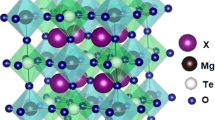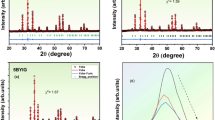Abstract
Phase-pure bismuth tantalate fluorites were successfully prepared via conventional solid-state method at 900 °C in 24–48 h. The subsolidus solution was proposed with the general formula of Bi3+x Ta1−x O7−x (0 ≤ x ≤ 0.184), wherein the formation mechanism involved a one-to-one replacement of Ta5+ cation by Bi3+ cation within ~4.6 mol% difference. These samples crystallised in a cubic symmetry, space group Fm-3 m with lattice constants, a = b = c in the range 5.4477(± 0.0037)–5.4580(± 0.0039) Å. A slight increment in the unit cell was discernible with increasing Bi2O3 content, and this may attribute to the incorporation of relatively larger Bi3+ cation in the host structure. The linear correlation between lattice parameter and composition variable showed that the Vegard’s law was obeyed. Both TGA and DTA analyses showed Bi3+x Ta1−x O7−x samples to be thermally stable as neither phase transition nor weight loss was observed within ~28–1000 °C. The AC impedance study of Bi3TaO7 samples was performed over the frequency range 5–13 MHz. At intermediate temperatures, ~350–850 °C, Bi3+x Ta1−x O7−x solid solution was a modest oxide ion conductor with conductivity, ~10−6–10−3 S cm−1; the activation energy was in the range 0.98–1.08 eV.














Similar content being viewed by others
References
Sammes NM, Tompsett GA, Näfe H, Aldinger F (1999) Bismuth based oxide electrolytes-structure and ionic conductivity. J Eur Ceram Soc 19:1801–1826
Ng SN, Tan YP, Taufiq-Yap YH (2009) Mechanochemical synthesis and characterization of bismuth-niobium oxide ion conductors. J Phys Sci 20:75–86
Fruth V, Ianculescu A, Berger D et al (2006) Synthesis, structure and properties of doped Bi2O3. J Eur Ceram Soc 26:3011–3016
Castro A, Aguado E, Rojo J, Herrero P, Enjalbert R, Galy J (1998) The new oxygen-deficient fluorite Bi3NbO7: synthesis, electrical behavior and structural approach. Mater Res Bull 33:31–41
Struzik M, Liu X, Abrahams I, Krok F, Malys M, Dygas JR (2012) Defect structure and electrical conductivity in the pseudo-binary system Bi3TaO7–Bi3NbO7. Solid State Ion 218:25–30
Zhou Wuzong (1992) Structural chemistry and physical properties of some ternary oxides in the Bi2O3-Ta2O5 system. J Solid State Chem 101:1–17
Ling CD, Withers RL, Schmid S, Thompson JG (1998) A review of bismuth-rich binary oxides in the systems Bi2O3–Nb2O5, Bi2O3–Ta2O5, Bi2O3–MoO3, and Bi2O3–WO3. J Solid State Chem 137:42–61
Shuk P, Wiemhöfer HD, Guth U, Göpel W, Greenblatt M (1996) Oxide ion conducting solid electrolytes based on Bi2O3. Solid State Ion 89:179–196
Mairesse G, Scrosati B, Magistris A, Mari C, Mariotto G (1993) Fast ion transport in solids. NATO ASI Ser Ser E Appl Sci 250:271
Ling CD (1999) Structural relationships among bismuth-rich phases in the Bi2O3–Nb2O5, Bi2O3–Ta2O5, Bi2O3–MoO3, and Bi2O3–WO3 systems. J Solid State Chem 148:380–405
Abrahams I, Krok F, Struzik M, Dygas J (2008) Defect structure and electrical conductivity in Bi3TaO7. Solid State Ion 179:1013–1017
Lin SE, Wei WCJ (2011) Long-term degradation of Ta2O5-doped Bi2O3 systems. J Eur Ceram Soc 31:3081–3086
Zhang G, Li M, Yu S, Zhang S, Huang B, Yu J (2010) Synthesis of nanometer-size Bi3TaO7 and its visible-light photocatalytic activity for the degradation of a 4BS dye. J Colloid Interface Sci 345:467–473
Chon MP, Tan KB, Khaw CC, Zainal Z, Taufiq-Yap YH, Chen SK, Tan PY (2014) Investigation of the phase formation and dielectric properties of Bi7Ta3O18. J Alloy Compd 590:479–485
Holdynski M, Sintyureva M, Liu X et al (2012) Phase and electrical behaviour in Bi4NbO8.5. J Phys: Condens Matter 24:45904
Rubbens A, Drache M, Roussel P, Wignacourt JP (2007) Raman scattering characterization of bismuth based mixed oxides with Bi2O3 related structures. Mater Res Bull 42:1683–1690
Wang XP, Corbel G, Kodjikian S, Fang QF, Lacorre P (2006) Isothermal kinetic of phase transformation and mixed electrical conductivity in Bi3NbO7. J Solid State Chem 179:3338–3346
Battle PD, Catlow CRA, Drennan J, Murray AD (1983) The structural properties of the oxygen conducting δ phase of Bi2O3. J Phys C Solid State Phys 16:L561
Zak AK, Majid WA, Abrishami ME, Yousefi R (2011) X-ray analysis of ZnO nanoparticles by Williamson-Hall and size–strain plot methods. Solid State Sci 13:251–256
Gonçalves NS, Carvalho JA, Lima ZM, Sasaki JM (2012) Size–strain study of NiO nanoparticles by X-ray powder diffraction line broadening. Mater Lett 72:36–38
Tan KB, Chon MP, Khaw CC, Zainal Z, Taufiq-Yap YH, Tan PY (2014) Novel monoclinic zirconolite in Bi2O3–CuO–Ta2O5 ternary system: phase equilibria, structural and electrical properties. J Alloy Compd 592:140–149
Carrazan SRG, Martin C, Rives V, Vidal R (1996) An FT-IR spectroscopy study of the adsorption and oxidation of propene on multiphase Bi, Mo and Co catalysts. Spectroc Acta Pt A Molec Biomolec Spectr 52:1107–1118
Irmawati R, Nasriah MN, Taufiq-Yap YH, Hamid SA (2004) Characterization of bismuth oxide catalysts prepared from bismuth trinitrate pentahydrate: influence of bismuth concentration. Catal Today 93:701–709
Fielicke A, Meijer G, Von Helden G (2003) Infrared multiple photon dissociation spectroscopy of transition metal oxide cluster cations. Eur Phys J D Atom Mol Opt Plasma Phys 24:69–72
Abram EJ, Sinclair DC, West AR (2001) Electrode-contact spreading resistance phenomena in doped-lanthanum gallate ceramics. J Electroceram 7:179–188
Tan MY, Tan KB, Zainal Z, Khaw CC, Chen SK (2012) Subsolidus formation and impedance spectroscopy studies of materials in the (Bi2O3)1−x(Y2O3)x binary system. Ceram Int 38:3403–3409
Irvine JT, Sinclair DC, West AR (1990) Electroceramics: characterization by impedance spectroscopy. Adv Mater 2:132–138
Dhivya L, Janani N, Palanivel B, Murugan R (2013) Li+ transport properties of W substituted Li7La3Zr2O12 cubic lithium garnets. AIP Adv 3:082115
Acknowledgement
The financial support from the Ministry of Higher Education, Malaysia via Fundamental Research Grant Scheme (FRGS) is gratefully appreciated.
Author information
Authors and Affiliations
Corresponding author
Rights and permissions
About this article
Cite this article
Firman, K., Tan, K.B., Khaw, C.C. et al. Doping mechanisms and electrical properties of bismuth tantalate fluorites. J Mater Sci 52, 10106–10118 (2017). https://doi.org/10.1007/s10853-017-1216-1
Received:
Accepted:
Published:
Issue Date:
DOI: https://doi.org/10.1007/s10853-017-1216-1




